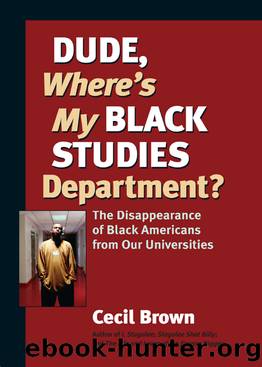Dude, Where's My Black Studies Department? by Cecil Brown

Author:Cecil Brown [Brown, Cecil]
Language: eng
Format: epub
ISBN: 978-1-58394-391-5
Publisher: North Atlantic Books
Published: 2011-06-07T00:00:00+00:00
The A&T College Lunch Counter Sit-in
One of the most significant events in the history of Black Studies was the sit-in at Greensboro, North Carolina, on February 1, 1960.
I remember vividly the Sunday that my Uncle Lofton and Aunt Amanda drove me to A&T College, a five-hour journey from Wilmington to Greensboro, to begin my freshman year. They were proud to see me off, mainly because they had never known anybody in our family to go to college. Aunt Amanda packed a lunch for me that included fried chicken. I admired her cooking and preferred her corn bread to store-bought white bread.
As I checked into my dormitory at Scott Hall, I could not imagine that I would be a part of history, that a few months later, in February 1960, I would participate in the first Black student sit-in.
The four students who led the sit-inâFranklin McCain, Joseph McNeil, Ezell Blair, Jr., and David Richmondâlived in my dormitory, and I got to know them all. For these young Black men, February 1, 1960, was a monumental day. It was the day they integrated the lunch counter in Greensboro, North Carolina. It was a monumental day for me too, because Iâalong with hundreds of other A&T studentsâjoined in the lunch boycott. Within weeks, Black students were sitting down in lunch counters across the country. White students didnât want to be left out, so they formed Students for a Democratic Society (SDS) and other groups to participate.
In his essay âThe White Race and Its Heroesâ in Soul On Ice, Eldridge Cleaver says that young White people saw the evil ways of their parents and forefathers and decided to throw over that inglorious past and join in with Black people. âIts first dramatic manifestation [i.e. âa political conflict between the generationsâ] was within the ranks of the Negro people, when college students in the South, fed up with Uncle Tomâs hat-in-hand approach to revolution, threw off the yoke of the NAACP,â Cleaver writes. âWhen these students initiated the first sit-ins, their spirit spread like a raging fire across the nation, and the technique of non-violent direct action, constantly refined and honed into a sharp cutting tool, swiftly matured.â79
Cleaver was correct in identifying that student sit-ins spread rapidly from one college to another one. He goes on to claim that there was a conflict between the young students and their elders: âThe older Negro âleaders,â who are now all die-hard advocates of this tactic, scolded the students for sitting-in. The students rained down contempt upon their hoary heads.â
Although this makes a powerful image, for the most part it is not true. At A&T College, our teachers and the older generation generally applauded what we did. In fact, the faculty and the administration wanted the sit-ins to be successful.
Cleaver was one of the first visionaries to connect the Black sit-ins to world struggle. Black Studies, he claimed, linked up âthe Negro revolution with national liberation movements around the world.⦠The âNegro leaders,â and the whites who depended upon them to control their people, were outraged by the impudence of the students.
Download
This site does not store any files on its server. We only index and link to content provided by other sites. Please contact the content providers to delete copyright contents if any and email us, we'll remove relevant links or contents immediately.
The Inner Game of Tennis by W. Timothy Gallwey(3479)
Unstoppable by Maria Sharapova(3409)
Urban Outlaw by Magnus Walker(3246)
Crazy Is My Superpower by A.J. Mendez Brooks(3208)
Mind Fuck by Manna Francis(3040)
The Social Psychology of Inequality by Unknown(2771)
The Fight by Norman Mailer(2709)
Unstoppable: My Life So Far by Maria Sharapova(2388)
Accepted by Pat Patterson(2219)
Going Long by Editors of Runner's World(2216)
Futebol by Alex Bellos(2138)
The Happy Runner by David Roche(2125)
Motorcycle Man by Kristen Ashley(2117)
Backpacker the Complete Guide to Backpacking by Backpacker Magazine(2111)
The Sports Gene: Inside the Science of Extraordinary Athletic Performance by David Epstein(2064)
Sea Survival Handbook by Keith Colwell(2044)
Peak: Secrets from the New Science of Expertise by Anders Ericsson & Robert Pool(1927)
Endure by Alex Hutchinson(1874)
The Call of Everest by Conrad Anker(1789)
